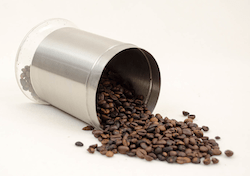
Many researchers have found that drinking coffee is beneficial for your health.
Although coffee seems like it’s not made up of much, it is loaded with antioxidants and nutrients (1, 2, 3, 4).
Coffee has been linked with improved mental and physical performance and increased metabolism (5, 6, 7).
Drinking coffee regularly has also been associated with a decreased risk of neurodegenerative diseases like Alzheimer’s and Parkinson’s as well as dementia (8, 9, 10, 11, 12, 13).
Coffee can benefit your physical health too. Drinking coffee can reduce your chances of developing type 2 diabetes, improve the health of your arteries and decrease your risk of liver cancer (14, 15, 16, 17).
However, even though people who drink coffee may have a longer life expectancy, coffee does contain acrylamide, a chemical that has been associated with detrimental health effects (18, 19).
Test your knowledge now or come back after reading this article to check your learning:
Infographic (Pin, Share or Embed)

Share This Infographic On Your Site
<p><a href='https://www.authoritydiet.com/acrylamide-coffee-cancer-heart-disease-risk/'><img src='https://www.authoritydiet.com/images/i/coffee-acrylamide-infographic-hd.jpg' border='0' /></a><br /><strong>Please include attribution to AuthorityDiet.com with this graphic.</strong></p>
Acrylamide Is a Harmful Chemical
Acrylamide (also known as acrylic amide) is a chemical that is produced in many foods when they are heated (20). It has the chemical formula C3H5NO and is a white odorless crystal compound soluble in water.
Some foods that contain higher levels of acrylamide than many other foods are potato chips and French fries.
Levels of acrylamide increase the longer the food is heated (21).
When foods are boiled, acrylamide is not produced. However, the chemical is produced when foods are baked, fried, roasted and microwaved (22).
Researchers have noted that high-carbohydrate foods produce more acrylamide than high-protein foods. They think that the acrylamide is produced when amino acids and sugars are heated to temperatures greater than 248° F or 120° C (23, 24).
The main chemical reaction that produces acrylamide is known as the Maillard reaction.
Acrylamide is found in a variety of foods (25). In fact, more than a third of the foods we eat may contain acrylamide (26).
The chemical is found in cigarette smoke (27). It is also found in coffee (28).

There is no difference in acrylamide levels in different species of coffee. When coffee beans are heated during the roasting process, acrylamide is formed.
However regular brewed coffee made from roasted coffee beans, a lighter color indicates that there is more acrylamide in the coffee. This is a surprising; the reason is because acrylamide is formed at the beginning of the coffee bean roasting cycle and it declines steeply toward to end of the process due to higher rates of elimination (43).
Although many animal studies have found that acrylamide is neurotoxic and carcinogenic, human disease researchers have not proven that the chemical causes cancer (26, 28) . However, the chemical does have properties that can cause cells to mutate.
Acrylamide is not only found in foods, however. It is used in the processing of drinking water and the manufacturing of many items, including cosmetics and certain fabrics (29).
Many studies have been conducted to research exposure to acrylamide in the workplace. Various official organizations have set acceptable levels of acrylamide in drinking water, occupational settings and cosmetic products.
Overexposure to the chemical in occupational settings can cause central nervous system damage. Neurotoxic effects in humans have been shown with high levels of environmental exposure. Other toxic effects have mainly been noted in animals (30, 31).
KEY POINT: Acrylamide is found in many foods that have been processed at high temperatures. It can also be found in drinking water and the environment. It may be detrimental to human health.
How Harmful Is Acrylamide?

As with many things that are not ideal for optimal health, Acrylamide is not considered hazardous to humans at moderate doses.
It is true that people who have been exposed to high levels of acrylamide in the workplace have developed central nervous system disorders (29, 30). It is also true that animal studies have found that the chemical can cause cancer when it is consumed (26).
However, acrylamide is broken down differently in the human body than in animals. In addition, the animal studies involved using much more of the chemical than humans would ever be exposed to by drinking coffee.
Most human studies have resulted in inconsistent findings (32).
Research that has found little correlation between arylamide and health problems may not have taken into account the fact that acrylamide intake is probably not consistent in most humans. As new foods appear on the market, more research must be conducted.
However, although the discovery of acrylamide in cooked food occurred relatively recently, in 2002, it is likely that acrylamide has been produced in cooked foods since the advent of fire as a cooking technique.
KEY POINT: Although people who are exposed to high levels of acrylamide in the workplace may suffer detrimental health effects and the chemical can cause cancer in animals, it is unlikely that most humans are exposed to detrimental doses from diet alone.
Does Coffee Contain Harmful Levels of Acrylamide?

Different types of coffee - freshly brewed, instant and coffee substitutes contain different amounts of acrylamide.
Freshly brewed coffee is made from roasted, ground coffee beans. The beans may be ground immediately before brewing or prior to packaging.
Water is passed through the grounds in some manner, picking up the flavor, aroma and nutrients in the coffee. This type of coffee may be brewed hot, cold or under pressure (as with espresso).
Instant coffee is made from roasted coffee grounds that have been brewed at a higher ratio of coffee to water than you would typically use for regular coffee.
Water is removed from the resulting coffee extract, resulting in dry granules that retain most of the nutrients and antioxidants but none of the moisture. The granules may be rehydrated with liquid to produce a drinkable beverage.
Coffee substitutes are made from other food products that are usually roasted and ground to create a coffee-like beverage. Barley and chicory are often used for this purpose.
In 2013, scientists looked at the levels of acrylamide in these different coffee variants. Coffee substitutes had the most acrylamide levels. Freshly brewed coffee had the least (33).
Most of the freshly brewed coffee samples contained fewer than 200 µg/kg of acrylamide. The mean level of acrylamide in coffee substitutes was 818 µg/kg. The mean level of the chemical in instant coffee was 358 µg/kg.
Coffee substitutes may contain more acrylamide depending on the substance used to make them. The more sugars the product has, the more likely it is to produce higher levels of acrylamide when roasted.
Most foods produce more acrylamide the longer they are cooked. Lighter coffee beans, which are roasted for longer periods of time, contain more acrylamide.
Acrylamide levels does not significantly differ between different coffee species e.g. Arabica vs. Robusta vs. interspecific hybrids.
One single cup of coffee (160 ml) delivered on average from 0.45 µg acrylamide in roasted coffee to 3.21 µg in coffee substitutes (33).
So what does this mean to coffee drinkers?
Safe daily intake level of acrylamide before carcinogenic levels was estimated to be 2.6μg/kg per day (42).
To put this into perspective, this would be equivalent of 182μg safe daily intake of acrylamide for a 70kg person. This person would need to drink 404 cups or 64 liters of roasted coffee brew in a day to reach carcinogenic levels. We can’t even drink that much water in a day.
You need to drink 64 liters of roasted coffee brew a day to reach carcinogenic levels.
Click to TweetSafe daily intake level of acrylamide before neurotoxic level is even higher at 40 μg/kg per day, equivalent to 6222 cups or 995 liters of roasted coffee brew a day.
As you can see, the acrylamide levels found in coffee are safe.
KEY POINT: Different types of coffee contain different levels of acrylamide. Freshly brewed coffee made from dark beans usually contains less of the chemical than instant coffee or coffee substitutes. Acrylamide levels in coffee is so safe that you are unable to drink the amount beyond the daily tolerable intake of acrylamide even if you try.
Does Drinking Coffee Increase the Risk of Disease?

Although the correlation between dietary acrylamide and cancer has not been proven, it should still be a consideration in your dietary habits. That said, the benefits of drinking coffee may outweigh the risks.
Many studies have linked coffee drinkers with a reduced risk of cancer. One meta-analysis found that coffee drinkers can lower their risk of liver cancer by 43% (34).
Drinking coffee can protect against colorectal, liver and breast cancers. However, research into coffee’s link with bladder and lung cancers is conflicting (35).
The polyphenols in coffee work as powerful antioxidants that fight free radicals and protect against many diseases (1).
Researchers consistently say that the acrylamide levels in the diet are not a concern. In addition, studies continue to show health benefits from drinking coffee.
In one study, postmenopausal women who drank up to three cups of coffee daily lowered their mortality risk associated with heart disease by 25% (36).
People with type 2 diabetes have a lower risk of dying from the disease if they have consistently drank coffee throughout their lives (37).
KEY POINT: The benefits of drinking coffee may outweigh the risks. Many studies have shown protective effects of coffee for certain cancers, and coffee may lower the risk of dying from heart disease and type 2 diabetes.
Should You Stop Drinking Coffee?

It is impossible to completely avoid your exposure to acrylamide even if you stop drinking coffee. The chemical is in second-hand smoke, drinking water and hundreds of other foods. If you cook your food, you are likely to be consuming acrylamide every day.
However, the average person takes in less acrylamide than the allowable maximum levels set forth by official organizations, such as the European Food Safety Authority (38).
In the future, it might even be possible to remove acrylamide from coffee. Some researchers have tried using enzymes collected from soil from a hot spring location in the U.S. to rid the coffee of acrylamide (39).
Vacuum-roasting coffee beans can also decrease acrylamide levels by up to 50% (40).
Even though current methods of roasting and brewing coffee don’t typically reduce acrylamide levels, however, coffee’s benefits still probably outweigh the risks. In addition, acrylamide levels in coffee are fairly low. You’re likely to consume plenty more from other sources anyway.
Studies have not proven that low levels of acrylamide harm your health. However, some research shows that the chemical can cause more problems with recurring exposure.
You Can Lower Your Acrylamide Levels in Other Ways
If you want to limit the levels of acrylamide that you’re exposed to but don’t want to cut out coffee, you can try the following options:
- Stop smoking.
- Lower your exposure to second-hand smoke.
- Eat more raw foods.
- Avoid fried food.
- Try not to burn your food when cooking it.
- Boil or steam food instead of roasting or grilling it.
- Store potatoes at a temperature higher than 60 degrees F (41).
- Drink coffee that is brewed from dark roasts instead of lighter roasts, coffee substitutes or instant coffee.
KEY POINT: You are exposed to many sources of acrylamide on a daily basis. Avoiding coffee isn’t likely to remove enough from your diet to make a difference. If you are concerned about your acrylamide levels, try making small changes to your lifestyle and cooking methods in order to take in less of the chemical.
Bottom Line
Although information about coffee and your health has been controversial over the years, many experts believe that it is beneficial for a number of reasons.
Coffee drinkers may have a lower risk of developing heart problems, type 2 diabetes or cognitive decline as they age.
However, coffee does contain acrylamide, a potentially harmful substance. No conclusive evidence has found that the levels of acrylamide in coffee are detrimental to human health, and it is possible that the health benefits outweigh the risks.
If you want to limit your exposure to the chemical, you may be able to do so by changing the type of coffee that you drink, changing your cooking methods and staying away from smoke.

